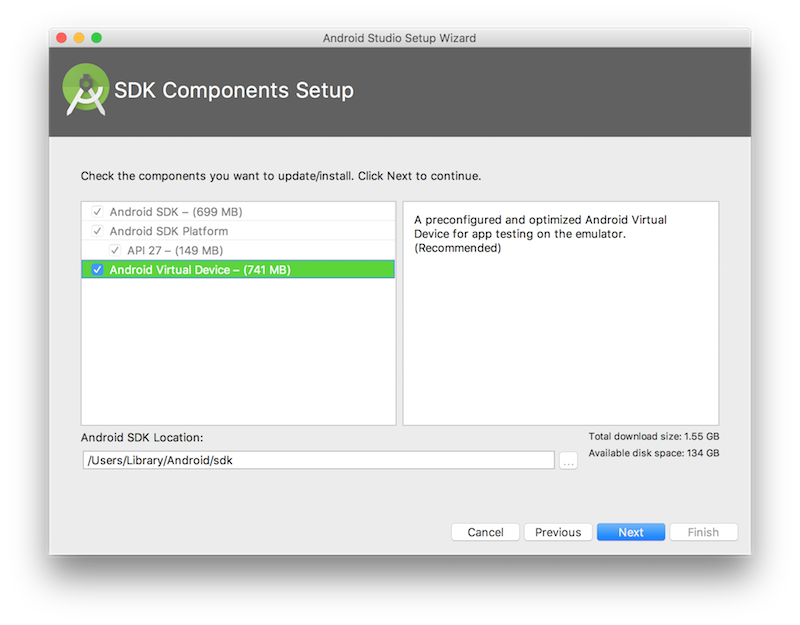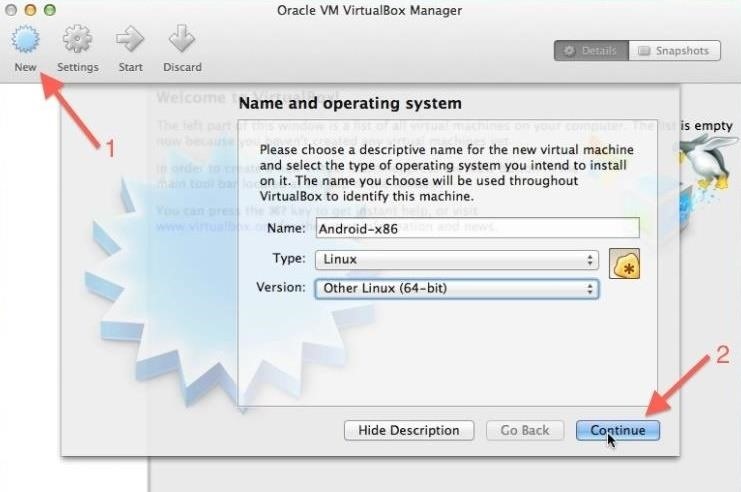Virtual Android On Mac
- Virtual Android On Mac Desktop
- Virtual Android On Mac Download
- Android Virtual Machine On Linux
- Virtual Android On Mac Laptop
An Android or iOS application or a browser gets emulated by an emulator on an operating system considered as a defined one, such as that of Mac and Windows. What it does is that it establishes virtual hardware conditions of that of an Android or iOS device. Following this, we use it for testing besides debugging. Download Latest Version for Windows. Genymotion for Mac is an easy-to-use Android emulator that has been designed to help app developers test their products within a safe, virtual environment. To install Genymotion for Mac, simply drag and drop the apps that are included in the archive, to your Applications directory. Download VirtualBox on your Mac machine, and then set it up with the necessary ISO image from Android-x86.org. You’ll be able to create an efficient emulator that allows you to play almost any.
Android is a mobile operating system (OS) based on the Linux kernel and currently developed by Google. Android-x86 is a project to port Android open source project to x86 platform, formerly known as “patch hosting for android x86 support”. The Android-x86 team created their own code base to provide support on different x86 platforms, and set up a git server to host it. It is an open source. Run Android Apps on Mac #1 BlueStacks — Best for Running Apps. BlueStacks (also called BlueStacks App Player) is the oldest and the most popular. #2 VirtualBox — Best for More Control. At the core, Android is also a Linux-based operating system. As it happens, you. #3 Nox Player Mac — Best.
-->This article explains how to use the Android Device Manager to createand configure Android Virtual Devices (AVDs) that emulate physical Androiddevices. You can use these virtual devices to run and test your appwithout having to rely on a physical device.
After you have verified that hardware acceleration is enabled (asdescribed inHardware Acceleration for Emulator Performance),the next step is to use the Android Device Manager (also referred toas the Xamarin Android Device Manager) to create virtual devices thatyou can use to test and debug your app.
Android Device Manager on Windows
This article explains how to use the Android Device Manager to create,duplicate, customize, and launch Android virtual devices.
You use the Android Device Manager to create and configure AndroidVirtual Devices (AVDs) that run in theAndroid Emulator.Each AVD is an emulator configuration that simulates a physical Androiddevice. This makes it possible to run and test your app in a variety ofconfigurations that simulate different physical Android devices.
Requirements
To use the Android Device Manager, you will need the following items:
Visual Studio 2019 Community, Professional, or Enterprise.
OR Visual Studio 2017 version 15.8 or later is required. Visual StudioCommunity, Professional, and Enterprise editions are supported.
Visual Studio Tools for Xamarin version 4.9 or later.
The Android SDK must be installed (seeSetting up the Android SDK for Xamarin.Android).Be sure to install the Android SDK at its default location if itis not already installed: C:Program Files (x86)Androidandroid-sdk.
The following packages must be installed (via theAndroid SDK Manager):
- Android SDK Tools version 26.1.1 or later
- Android SDK Platform-Tools 27.0.1 or later
- Android SDK Build-Tools 27.0.3 or later
- Android Emulator 27.2.7 or later.
These packages should be displayed with Installed status as seen inthe following screenshot:
Launching the Device Manager
Launch the Android Device Manager from the Tools menu byclicking Tools > Android > Android Device Manager:
If the following error dialog is presented on launch, see theTroubleshooting section for workaroundinstructions:
Main Screen
When you first launch the Android Device Manager, it presents a screenthat displays all currently-configured virtual devices. For eachvirtual device, the Name, OS (Android Version), Processor,Memory size, and screen Resolution are displayed:
When you select a device in the list, the Start button appears onthe right. You can click the Start button to launch the emulatorwith this virtual device:
After the emulator starts with the selected virtual device, theStart button changes to a Stop button that you can use to haltthe emulator:
New Device
To create a new device, click the New button (located in the upperright-hand area of the screen):
Clicking New launches the New Device screen:
To configure a new device in the New Device screen, use thefollowing steps:
Give the device a new name. In the following example, the new deviceis named Pixel_API_27:
Select a physical device to emulate by clicking the Base Devicepull-down menu:
Select a processor type for this virtual device by clicking theProcessor pull-down menu. Selecting x86 will provide thebest performance because it enables the emulator to take advantageof hardware acceleration.The x86_64 option will also make use of hardware acceleration,but it runs slightly slower than x86 (x86_64 is normallyused for testing 64-bit apps):
Select the Android version (API level) by clicking the OSpull-down menu. For example, select Oreo 8.1 - API 27 to createa virtual device for API level 27:
If you select an Android API level that has not yet been installed, theDevice Manager will display A new device will be downloadedmessage at the bottom of the screen – it will download andinstall the necessary files as it creates the new virtual device:
If you want to include Google Play Services APIs in your virtualdevice, enable the Google APIs option. To include the GooglePlay Store app, enable the Google Play Store option:
Note that Google Play Store images are available only for some basedevice types such as Pixel, Pixel 2, Nexus 5, and Nexus 5X.
Edit any properties that you need to modify. To make changes toproperties, seeEditing Android Virtual Device Properties.
Add any additional properties that you need to explicitly set. TheNew Device screen lists only the most commonly-modifiedproperties, but you can click the Add Property pull-down menu(at the bottom) to add additional properties:
You can also define a custom property by selecting Custom... atthe top of the property list.
Click the Create button (lower right-hand corner) to create thenew device:
You might get a License Acceptance screen. Click Accept ifyou agree to the license terms:
The Android Device Manager adds the new device to the list ofinstalled virtual devices while displaying a Creating progressindicator during device creation:
When the creation process is complete, the new device is shown inthe list of installed virtual devices with a Start button,ready to launch:
Edit Device
To edit an existing virtual device, select the device and click theEdit button (located in the upper right-hand corner of the screen):
Clicking Edit launches the Device Editor for the selected virtual device:
The Device Editor screen lists the properties of the virtual deviceunder the Property column, with the corresponding values of each property inthe Value column. When you select a property, a detailed descriptionof that property is displayed on the right.
To change a property, edit its value in the Value column.For example, in the following screenshot the hw.lcd.density propertyis being changed from 480 to 240:
After you have made the necessary configuration changes, click the Save button.For more information about changing virtual device properties, seeEditing Android Virtual Device Properties.
Additional Options
Additional options for working with devices are available from theAdditional Options (…) pull-down menu in the upperright-hand corner:
The additional options menu contains the following items:
Duplicate and Edit – Duplicates the currently-selecteddevice and opens it in the New Device screen with a differentunique name. For example, selecting Pixel_API_27 and clickingDuplicate and Edit appends a counter to the name:
Reveal in Explorer – Opens a Windows Explorer window in thefolder that holds the files for the virtual device. For example,selecting Pixel_API_27 and clicking Reveal in Explorer opensa window like the following example:
Factory Reset – Resets the selected device to its defaultsettings, erasing any user changes made to the internal state of thedevice while it was running (this also erases the currentQuick Bootsnapshot, if any). This change does not alter modifications that youmake to the virtual device during creation and editing. A dialog boxwill appear with the reminder that this reset cannot be undone. ClickFactory Reset to confirm the reset:
Delete – Permanently deletes the selected virtual device. Adialog box will appear with the reminder that deleting a devicecannot be undone. Click Delete if you are certain that you wantto delete the device.
Note
If you are using a Mac with an Apple chip, such as the M1, you will need to install the Android Emulator for M1 preview from GitHub.
Android Device Manager on macOS
This article explains how to use the Android Device Manager to create,duplicate, customize, and launch Android virtual devices.
You use the Android Device Manager to create and configure AndroidVirtual Devices (AVDs) that run in theAndroid Emulator.Each AVD is an emulator configuration that simulates a physical Androiddevice. This makes it possible to run and test your app in a variety ofconfigurations that simulate different physical Android devices.
Requirements
To use the Android Device Manager, you will need the following items:
Visual Studio for Mac 7.6 or later.
The Android SDK must be installed (seeSetting up the Android SDK for Xamarin.Android).
The following packages must be installed (via theAndroid SDK Manager):
- SDK tools version 26.1.1 or later
- Android SDK Platform-Tools 28.0.1 or later
- Android SDK Build-Tools 26.0.3 or later
These packages should be displayed with Installed status as seen inthe following screenshot:
Launching the Device Manager
Launch the Android Device Manager by clicking Tools > Device Manager:
If the following error dialog is presented on launch, see theTroubleshooting section for workaroundinstructions:

Main Screen
When you first launch the Android Device Manager, it presents a screenthat displays all currently-configured virtual devices. For eachvirtual device, the Name, OS (Android Version), Processor,Memory size, and screen Resolution are displayed:
When you select a device in the list, the Play button appears onthe right. You can click the Play button to launch the emulatorwith this virtual device:
After the emulator starts with the selected virtual device, thePlay button changes to a Stop button that you can use to haltthe emulator:
When you stop the emulator, you may get a prompt asking if you want to savethe current state for the next quick boot:
Saving the current state will make the emulator boot faster when this virtualdevice is launched again. For more information about Quick Boot, seeQuick Boot.
New Device
To create a new device, click the New Device button (located in the upperleft-hand area of the screen):

Clicking New Device launches the New Device screen:
Use the following steps to configure a new device in the New Devicescreen:
Give the device a new name. In the following example, the new deviceis named Pixel_API_27:
Select a physical device to emulate by clicking the Base Devicepull-down menu:
Select a processor type for this virtual device by clicking theProcessor pull-down menu. Selecting x86 will provide thebest performance because it enables the emulator to take advantageof hardware acceleration.The x86_64 option will also make use of hardware acceleration,but it runs slightly slower than x86 (x86_64 is normallyused for testing 64-bit apps):
Select the Android version (API level) by clicking the OSpull-down menu. For example, select Oreo 8.1 - API 27 to createa virtual device for API level 27:
If you select an Android API level that has not yet been installed,the Device Manager will display A new device will be downloadedmessage at the bottom of the screen – it will download andinstall the necessary files as it creates the new virtual device:
If you want to include Google Play Services APIs in your virtualdevice, enable the Google APIs option. To include the GooglePlay Store app, enable the Google Play Store option:
Note that Google Play Store images are available only for some basedevice types such as Pixel, Pixel 2, Nexus 5, and Nexus 5X.
Edit any properties that you need to modify. To make changes toproperties, seeEditing Android Virtual Device Properties.
Add any additional properties that you need to explicitly set. TheNew Device screen lists only the most commonly-modifiedproperties, but you can click the Add Property pull-down menu(at the bottom) to add additional properties:
You can also define a custom property by clicking Custom...at the top of this property list.
Click the Create button (lower right-hand corner) to create thenew device:
The Android Device Manager adds the new device to the list ofinstalled virtual devices while displaying a Creating progressindicator during device creation:
When the creation process is complete, the new device is shown inthe list of installed virtual devices with a Start button,ready to launch:
Edit Device
To edit an existing virtual device, select the Additional Optionspull-down menu (gear icon) and select Edit:
Clicking Edit launches the Device Editor for the selected virtual device:
The Device Editor screen lists the properties of the virtual deviceunder the Property column, with the corresponding values of each property inthe Value column. When you select a property, a detailed descriptionof that property is displayed on the right.
To change a property, edit its value in the Value column.For example, in the following screenshot the hw.lcd.density propertyis being changed from 480 to 240:

After you have made the necessary configuration changes, click the Save button.For more information about changing virtual device properties, seeEditing Android Virtual Device Properties.
Additional Options
Additional options for working with a device are available from thepull-down menu located to the left of the Play button:
The additional options menu contains the following items:
Edit – Opens the currently-selected device in the deviceeditor as described earlier.
Duplicate and Edit – Duplicates the currently-selecteddevice and opens it in the New Device screen with a differentunique name. For example, selecting Pixel 2 API 28 and clickingDuplicate and Edit appends a counter to the name:
Reveal in Finder – Opens a macOS Finder window in thefolder that holds the files for the virtual device. For example,selecting Pixel 2 API 28 and clicking Reveal in Finder opensa window like the following example:
Factory Reset – Resets the selected device to its defaultsettings, erasing any user changes made to the internal state of thedevice while it was running (this also erases the currentQuick Bootsnapshot, if any). This change does not alter modifications that youmake to the virtual device during creation and editing. A dialog boxwill appear with the reminder that this reset cannot be undone. ClickFactory Reset to confirm the reset.
Delete – Permanently deletes the selected virtual device. Adialog box will appear with the reminder that deleting a devicecannot be undone. Click Delete if you are certain that you wantto delete the device.
Troubleshooting
The following sections explain how to diagnose and work around problemsthat may occur when using the Android Device Manager to configurevirtual devices.
Android SDK in Non-Standard Location
Typically, the Android SDK is installed at the following location:
C:Program Files (x86)Androidandroid-sdk
If the SDK is not installed at this location, you may get this error when you launchthe Android Device Manager:
To work around this problem, use the following steps:
From the Windows desktop, navigate toC:UsersusernameAppDataRoamingXamarinDeviceManager:
Double-click to open one of the log files and locate the Configfile path. For example:
Navigate to this location and double-click user.config to open it.
In user.config, locate the
<UserSettings>element and add anAndroidSdkPath attribute to it. Set this attribute to the pathwhere the Android SDK is installed on your computer and save thefile. For example,<UserSettings>would look like the following ifthe Android SDK was installed at C:ProgramsAndroidSDK:
After making this change to user.config, you should be able tolaunch the Android Device Manager.
Wrong Version of Android SDK Tools
If Android SDK tools 26.1.1 or later is not installed, you may see thiserror dialog on launch:
If you see this error dialog, click Open SDK Manager to open theAndroid SDK Manager. In the Android SDK Manager, click the Toolstab and install the following packages:
- Android SDK Tools 26.1.1 or later
- Android SDK Platform-Tools 27.0.1 or later
- Android SDK Build-Tools 27.0.3 or later
Snapshot disables WiFi on Android Oreo
If you have an AVD configured for Android Oreo with simulated Wi-Fi access,restarting the AVD after a snapshot may cause Wi-Fi access to become disabled.
To work around this problem,
Select the AVD in the Android Device Manager.
From the additional options menu, click Reveal in Explorer.
Navigate to snapshots > default_boot.
Delete the snapshot.pb file:
Restart the AVD.
After these changes are made, the AVD will restart in a state thatallows Wi-Fi to work again.
Wrong Version of Android SDK Tools

If Android SDK tools 26.1.1 or later is not installed, you may see thiserror dialog on launch:
If you see this error dialog, click OK to open the Android SDKManager. In the Android SDK Manager, click the Tools tab andinstall the following packages:
- Android SDK Tools 26.1.1 or later
- Android SDK Platform-Tools 28.0.1 or later
- Android SDK Build-Tools 26.0.3 or later
Snapshot disables WiFi on Android Oreo
If you have an AVD configured for Android Oreo with simulated Wi-Fi access,restarting the AVD after a snapshot may cause Wi-Fi access to become disabled.
To work around this problem,
Select the AVD in the Android Device Manager.
From the additional options menu, click Reveal in Finder.
Navigate to snapshots > default_boot.
Delete the snapshot.pb file:
Restart the AVD.

After these changes are made, the AVD will restart in a state thatallows Wi-Fi to work again.
Generating a Bug Report
Virtual Android On Mac Desktop
If you find a problem with the Android Device Manager thatcannot be resolved using the above troubleshooting tips, please file abug report by right-clicking the title bar and selecting Generate BugReport:
If you find a problem with the Android Device Manager thatcannot be resolved using the above troubleshooting tips, please file abug report by clicking Help > Report a Problem:
Summary
This guide introduced the Android Device Manager available in VisualStudio Tools for Xamarin and Visual Studio for Mac. It explainedessential features such as starting and stopping the Android emulator,selecting an Android virtual device (AVD) to run, creating new virtualdevices, and how to edit a virtual device. It explained how toedit profile hardware properties for further customization, and itprovided troubleshooting tips for common problems.
Related Links
Related Video
Find more Xamarin videos on Channel 9 and YouTube.
To install and experience the Android x86 on PC you nee two things VirtualBox or Vmware software and Android x86 ISO image or Android x86 VM image.
Android, the most popular operating system, now not only just limited to your smartphones. If you have the curiosity to use it on your personal computer (PC) then you can do it. Now, the users those have a spare machine to test the Android operating system on PC can use the Android ISO image. You just need to make a bootable USB drive using the downloaded ISO images of Android 7.0, 8.0, 9.0 or whatever the version you want. However, if you don’t have the extra system to test the Android then another option which available is Virtualization. The most popular Virtualization software are VirtualBox and Vmware. The VirtualBox is an open source tool and available for Linux, Windows, and Mac. While the other one Vmware is also available for the OS mentioned but it is proprietary software.
You can either use the Android ISO image to install the Android OS on VirtualBox / VMware or simply download the pre-configured Android x86 Virtual machine image (VM). The benefit of using Virtual Image is, you don’t need to configure storage, Ram, other hardware configuration for the OS on Virtualization software. Just download the Android VM image and it simply boots as a preinstalled machine. It saves a lot of time.
Prerequisites to install Android x86
To install and experience the Android on PC you nee two things VirtualBox or Vmware software and Android x86 ISO image or Android x86 VM image. Here in this tutorial, we are going to use the VirtualBox and to save time and make it easy to install the Android on PC, the Android x86 VM image.
Here are the Links to download the above-mentioned prerequisites software.
VirtualBox: Link
Android X86 VM image: Link( VM image available while writing the article are: Android-x86 8.1-RC2 Oreo, Nougat, Marshmallow (R3), 5.1 (RC1), Android x86 4.4 r1 and more)
Android x86 ISO image: Link(For those don’t want to use the Andriod VM image)
Install Android OS on VirtualBox and VMware
Note: It doesn’t matter which operating system you are using it could be Linux, Windows or Mac because the process of working with Virtual or Vmware is the same for all of them. While writing article Android OReo was the latest build.
Step 1: Download VirtualBox or VMware player
First of all, download and install the VirtualBox on your PC machine ( Linux, Windows or Mac).
Step 2: Get Android Oreo OS VM image
After the installation of the Virtualbox, you need to download the VM image from the link given above given in this article. On the website, you will find two images one is for VirtualBox and other is meant for Vmware. According to your software select that. As we are using the VirtualBox, so we downloaded the VirtualBox image. While writing this the article the latest Android VM image available on the website was Android-x86 8.1-RC1 Oreo.
Step 3: Extract Android X86 VM image file
The downloaded the Android X86 VM image file will be in a 7z archive format. After downloading you need to extract the Android VM image from using the normal Winrar or 7zip or any other archive/ compression software.
Step 4: Run the VirtualBox.
- Click on the NEW button from the VirtualBox menu.
- Give some name to your Android virtual machine, like we have given Android test H2s.
- From Type’s drop-down select the Other and Version = other/unknown.
- Select the size of memory you want to provide your operating system. We have assigned 2GB for fluid functions.
- From the Hard disk section, select the option- Use an existing virtual hard disk file.
- Click on the Folder icon.
Step 5: Select the extracted Android X86 VDI image which you downloaded above.
Step 6: Click on the Create button.
Step 7: Select the created Android x86 Virtual machine from the left panel of VirtualBox.
Virtual Android On Mac Download
Step 8: Now Click on the START button given on the VirtualBox menu.
Step 9: The Android Virtual Machine will start.
Step 10: Select the normal mode- Android X86 8.1-rc1
Android Virtual Machine On Linux
Step 11: Android x86 is installed
The OS has been installed and it will boot to provide you with a familiar screen like your smartphone.
We tried to install the PUBG on the Android x86 Virtual Machine on Linux PC and it worked…
Virtual Android On Mac Laptop
Other Useful Resources: